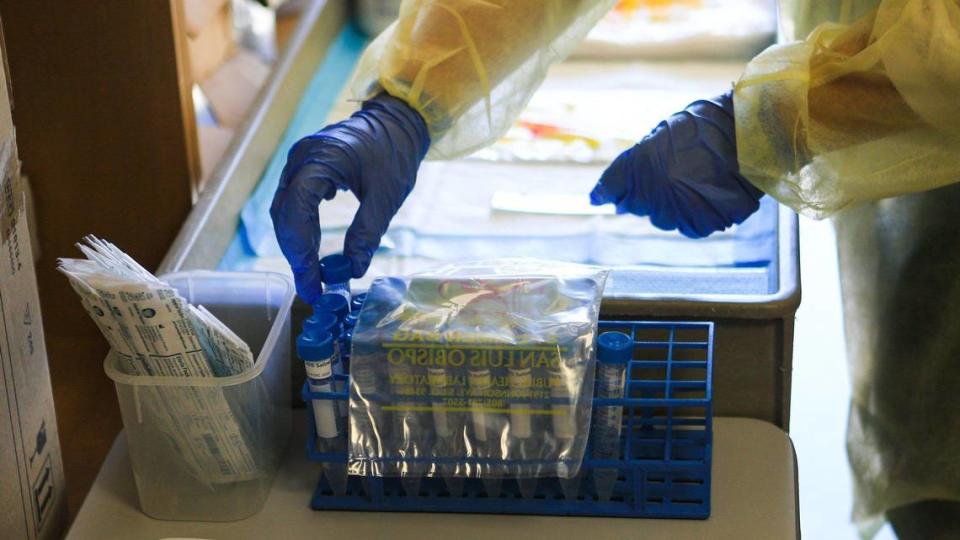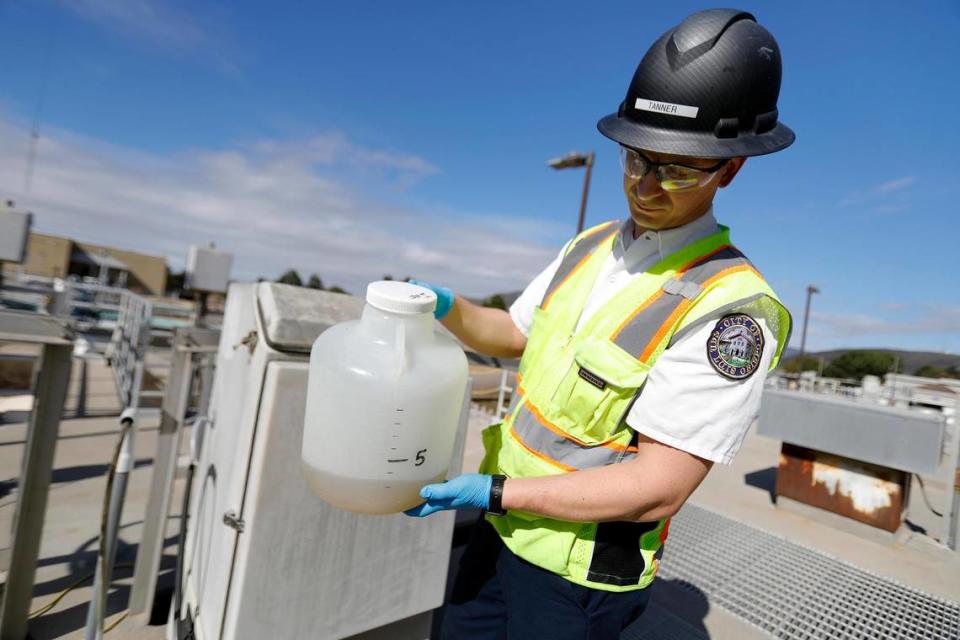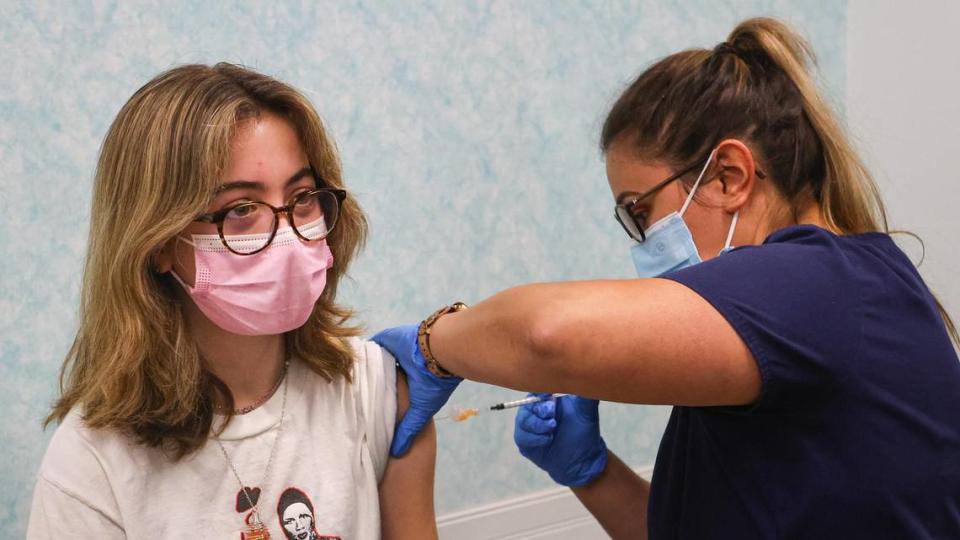Are COVID cases on the rise in SLO County? Scientists break down the numbers
As new subvariants of the novel coronavirus circulate across the country, San Luis Obispo County is seeing a rise in cases of the deadly virus, local health experts say.
“We are seeing increases in the number of cases of COVID in our community,” San Luis Obispo County Public Health Director Dr. Penny Borenstein confirmed.
Though the county stopped counting individual COVID-19 cases in September 2022, public health officials continue to monitor the spread of the SARS-CoV-2 virus that causes COVID-19 by looking at other metrics such as wastewater surveillance, test positivity rate, outbreaks in congregate living settings, hospitalizations and deaths.
Most of those data points to an increase in COVID-19 locally this summer due to increased socializing — and that trend is expected to continue into the fall along with the spread of other respiratory viruses such as influenza, respiratory syncytial virus.
Borenstein said that, without counting each individual case of COVID-19, tracking the prevalence of the novel coronavirus in SLO County is “getting harder and harder to do.”

SLO County wastewater surveillance showed steady increase in COVID-19
Wastewater analysis showed an increase in the SARS-CoV-2 virus, the virus that causes the COVID-19 disease, detected in participating sewersheds this summer, according to Jessie Burmester, infectious disease epidemiologist at the county Public Health Department.
“We headed into August with some noisy wastewater data for July, meaning we were seeing random increases observed at isolated wastewater sites,” Burmester said. “However, this noise turned into observable increases at all sites for the month of August.”
The most recent wastewater data from the week of Aug. 20-26 indicated a slight drop in the virus at all participating sewersheds in the county, Burmester said.
“It’s hopeful,” she said, but SLO County isn’t out of the woods yet.
“Schools have come back from summer break and colleges are starting soon,” she said. “So we’ll be watching wastewater to see if this decrease-slash-plateau sustains or changes.”
The transition to wastewater surveillance allowed health officials to monitor the presence of the virus without relying on public participation in disease monitoring.
Wastewater offers a population-level look at the coronavirus and allows scientists to detect the virus before people become symptomatic. Wastewater monitoring is also inclusive of asymptomatic infection in a population that contributes to a particular sewershed.
The shift from counting COVID-19 infection to using wastewater came around the time at-home antigen testing became more widely available and fewer people were getting tested at health care facilities, Burmester said.
With fewer people getting tested in the health care setting, “We don’t have the same information and insights that we used to have,” she said. “So wastewater has been a really nice kind of supplement.”
Scientists analyze wastewater collected in local sewersheds for the presence of the SARS-CoV-2 virus.
If a person is infected with the virus, genetic material from the virus that causes COVID-19 disease is shed in human waste such as saliva, urine and feces, which goes down the drain and into the wastewater.
Sewersheds in five locations are currently participating in county-level wastewater monitoring, she said.
Nipomo, Los Osos, Cambria and the South County Sanitation District, which includes wastewater from Arroyo Grande, Grover Beach and Oceano, are all monitoring wastewater using the same methodologies, scales and sampling intervals, according to the SLO County COVID-19 data portal.
The city of Paso Robles is also participating in wastewater surveillance, but it is analyzed differently and contained in a separate graph.
The county has been successful in accessing different funding streams to continue wastewater monitoring, which can be an expensive disease monitoring strategy, Burmester said.
Wastewater data from the city of San Luis Obispo stopped being imported to the county portal on July 25 because the city received a grant from the California Department of Public Health to join the Drinking Water and Radiation Laboratory Branch, which will include monitoring wastewater for viral pathogens as well as other contaminants, she said.
The city of Atascadero stopped participating in wastewater surveillance on June 16, according to the data portal, although it’s not clear why.

Hospitalizations for coronavirus spike in SLO County
Health officials said metrics such as test positivity and hospitalizations are considered a “lagging indicator” when combined with wastewater, meaning that presence of the virus in the wastewater will rise and fall a week or two before hospitalizations and test positivity follows a similar increase or decrease.
After the bump in SARS-CoV-2 detected in SLO County sewersheds in early August, coronavirus-related hospitalizations spiked from zero in the past few weeks to 12 last week, Borenstein wrote in an email.
Another indicator the SLO County Public Health Department uses to gauge COVID-19 cases in the county is disease outbreaks in congregate care settings, provided by the California Occupational Safety and Health Administration.
Public Health learned of 10 COVID-19 outbreaks in congregate care settings in San Luis Obispo County as of Friday, Borenstein said.
That’s a considerable increase from the typical rate of zero to three outbreaks reported in the county by Cal/OSHA each week.
Borenstein said another indicator that Public Health looks at to gauge COVID-19 impacts is the amount of treatment prescribed by pharmacies in the county.

More coronavirus treatment has been requested at pharmacies recently, she said.
Data from the state health department shows more COVID-19 tests are showing up positive in San Luis Obispo County and elsewhere in California.
In San Luis Obispo County, 14.2% of COVID-19 tests taken in the seven days ending Aug. 21 were positive, according to CDPH data. That is a 2.2% increase in test positivity from the previous seven days.
The test positivity rate in SLO County is slightly higher than the test positivity rate for all of California, which was 13.2% for the same period.
Test positivity should not be used alone to gauge the impacts of COVID-19, Burmester said.
The metric has its limits because it relies on tests taken in a health facility that are later reported, meaning that rapid tests aren’t counted among the numbers.
“While it does give us some insights, it also does have its barriers,” she said.

When are COVID-19 boosters going to be available?
Scientists have identified new Omicron subvariants in California, with EG.5 and XBB lineages comprising the majority of infections in the state, according to the state health department.
These iterations of the Omicron virus are more subtle changes that don’t necessarily point to substantial changes in the virus or disease, Borenstein said.
“Distinct from when we went from Alpha to Delta to Omicron — those are big shifts in the characteristics of the virus,” Borenstein said. “What we’ve been seeing ... are much more subtle variations in virus compositions, (the) genetic composition.”
The existing bivalent booster shot, which targets the original strain of the novel coronavirus and the Omicron strain, should still be effective at targeting the subvariants circulating today.
Borenstein anticipates that a new monovalent booster, which targets only the Omicron strain, may be released in September.
In April, the Centers for Disease Control and Prevention recommended people 65 and older and those with compromised immune systems get a second dose of the bivalent booster.
Borenstein said anyone in those risk groups who has not received a first dose of the bivalent booster may want to do so.
People who have not received the bivalent booster and are not at elevated risk can decide whether to obtain the bivalent booster and the forthcoming monovalent booster, or just wait for the new booster.
“We think that this new monovalent booster may be out as early as late September and so people may want to wait for that at this point, since we’re so close,” she said.
There is no risk that comes from getting the a first or second dose of bivalent booster now and the monovalent booster later, she said.

Bump in SLO County COVID numbers is consistent with previous summers
The recent uptick in COVID-19 circulating is nothing new for SLO County, health officials said.
Borenstein and Burmester said the increase in COVID-19 likely has to do with summer socializing.
“Summer affords us the opportunity to travel, mingle and go to large events like fairs, concerts and parades,” Burmester said. “And that actually brings elevated risk for disease transmission. So summer illnesses by themselves are nothing new, but they have become more common with COVID-19.”
Though disease monitoring shows an increase in COVID-19 locally this summer, Borenstein said the numbers are less extreme than in the summer of 2021 and the summer of 2022.

